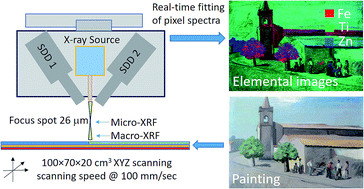Real-time elemental imaging of large dimension paintings with a novel mobile macro X-ray fluorescence (MA-XRF) scanning technique†
Abstract
A novel mobile macro-XRF (MA-XRF) scanning technique allowing real-time elemental imaging is presented for the investigation of macroscopic paintings. The instrument is based on a microfocus X-ray tube focused with a polycapillary and two SDD detectors operated simultaneously in a time-list event mode. The scanner is based on a three-axis system covering a dimension of 110 × 70 × 20 cm3. MA-XRF scanning is generally performed by positioning samples out of the polycapillary focus with the primary X-ray beam presenting a spot size in the range of hundreds of microns. However, a lateral resolution of up to 25 μm can be achieved at the focus position, allowing complementary use of the scanner for both micro-XRF and macro-XRF mapping. Scanning of artworks is performed with a maximum continuous speed of 100 mm s−1. The full area is covered in 4.3 h in the case of final images presenting a 500 μm pixel size (i.e., corresponding to a dwell time per pixel of 5 ms). The system is controlled with a custom developed control unit (CU) including a graphical user interface (GUI) programmed in Labview for real-time control of all sensors in the scanner and for real-time elaboration of X-ray data. X-ray spectra are processed during the scanning by the least square fast fitting procedure developed in PyMCa and integrated in the system. Up to 7000 fitted spectra per second are possible. A number of editing, processing and mathematical tools are available to users in the GUI and can be applied in a live mode to the forming elemental images. The sum spectrum and maximum pixel spectrum are continuously updated. Final images are available at the end of the scanning and, in most of the cases, they are ready for the interpretation.



 Please wait while we load your content...
Please wait while we load your content...